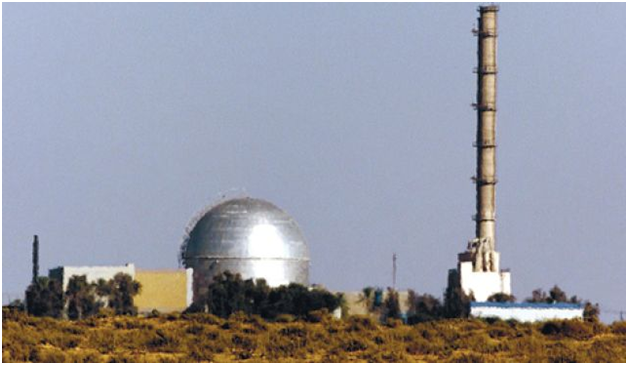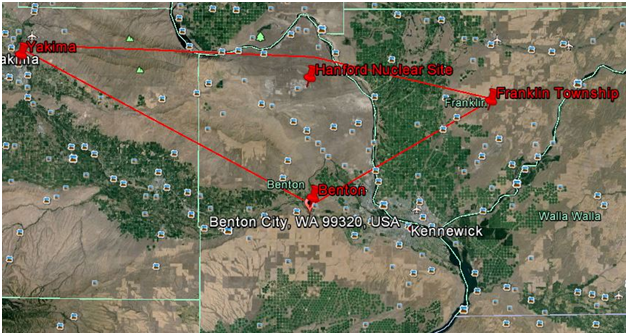
Blog
-
Geiger Readings for November 11, 2014
Ambient office = 102 nanosieverts per hourAmbient outside = 142 nanosieverts per hourSoil exposed to rain water = 121 nanosieverts per hourYellow bell pepper from Central Market = 102 nanosieverts per hourTap water = 102 nanosieverts per hourFiltered water = 94 nanosieverts per hour -
Nuclear Weapons 96 – Israel Maintains Secrecy About Their Nuclear Arsenal
I have blogged about Israel’s nuclear arsenal in the past. Although Israel will not publicly admit to having nuclear weapons, it is generally believed that they do have deliverable nuclear warheads. Israel has never signed the 1970 Nuclear Non-Proliferation Treaty. New information has just surfaced about the Israeli arsenal in an article in the Bulletin of Atomic Scientists from two nuclear security scholars at the Federation of American Scientists.
Over the last couple of decades a wide variety of agencies and analysts have estimate that Israel possesses from seventy five to four hundred nuclear warheads. The high estimate was based on the assumption that all the fissile material created at Israel’s Dimona reactor would be used to build nuclear weapons. The authors of the new study have decided that Israel probably keeps a stockpile of weapons grade plutonium This would reduce the estimation of their warhead stockpile. If Israel is mainly concerned about deterrence, then its arsenal would only need to contain big high-yield warheads. The number of these warhead would not exceed Israel’s long range delivery systems.
Israel has hundreds of F-16 combat planes but the report’s authors conclude that there would only be one or two F-16 squadrons that would have special trained crews, specific procedures and modifications necessary to deliver nuclear warheads. The authors have used satellite imagery to estimate the number of nuclear capable Jericho long range ballistic missiles. They claim that earlier estimations of a hundred missiles are much too high. The satellite pictures only show twenty three caves that could hold such missiles. This is the same number of nuclear capable missiles that were estimated in a White House memo written in 1969. With respect to submarine delivery systems, there are some reports that Israel has been developing nuclear capable Harpoon cruise missiles but the report does not take a position either for or against this possibility.
The report is skeptical about the possibility that Israel has tactical or battlefield nuclear devices. This type of nuclear weapon requires extensive testing and there is no evidence that Israel has conducted any nuclear tests. Without this type of testing, it is unlikely that Israel could develop the technical capability for such tactical nuclear weapons. The authors conclude that Israel’s nuclear doctrine is probably centered around deterring an attack or allowing Israel to strike back if attacked. They don’t believe that Israel sees nuclear warheads as having battlefield potential.
Because Israel has decided to keep their nuclear arsenal secret, that prevents them from openly carrying out testing that would advance their technology and it also prevents them from openly using their nuclear arsenal as a bargaining chip in international negotiations. If Israel admitted the existence of its nuclear arsenal, then its Muslim neighbors would be scrambling to develop their own nuclear weapons. This would destabilize the whole region and possibly lead to nuclear war. For the moment, it is just as well that Israel has been keeping its nuclear capability secret.
Dimona reactor in Israel:
-
Geiger Readings for November 10, 2014
Ambient office = 115 nanosieverts per hourAmbient outside = 58 nanosieverts per hourSoil exposed to rain water = 63 nanosieverts per hourIceberg lettuce from Central Market = 137 nanosieverts per hourTap water = 106 nanosieverts per hourFiltered water = 97 nanosieverts per hour -
Geiger Readings for November 9, 2014
Ambient office = 116 nanosieverts per hourAmbient outside = 89 nanosieverts per hourSoil exposed to rain water = 110 nanosieverts per hourRedleaf lettuce from Central Market = 67 nanosieverts per hourTap water = 100 nanosieverts per hourFiltered water = 91 nanosieverts per hour -
Geiger Readings for November 8, 2014
Ambient office = 84 nanosieverts per hourAmbient outside = 93 nanosieverts per hourSoil exposed to rain water = 87 nanosieverts per hourVine ripened tomato from Central Market = 97 nanosieverts per hourTap water = 73 nanosieverts per hourFiltered water = 58 nanosieverts per hourRockfish – Caught in USA = 103 nanosieverts per hour -
Radioactive Waste 106 – Rare Birth Defects Four Times Average Around Hanford Nuclear Reservation
I have blogged recently about the subtle long-term effects of radiation exposure on human health. It can take decades for radiation damage to manifest as illness so it is very difficult to pin down the dangers of radioactive contaminants. Recently there have been studies that support the idea that radiation from nuclear power plants, uranium mines, use of depleted uranium, nuclear waste and nuclear test can be connected to human illnesses.
In April of this year the News Network and Broadcast Collective published a report that rare birth defects in the three counties that border the Hanford Nuclear Reservation in Washington States are four hundred percent above normal. Hanford is one of the most radioactively contaminated sites in the world; the legacy of decade of nuclear weapons production with little concern for safety or environmental impact. An epidemiologist from the Center for Disease Control and Prevention stated that the cluster of birth defects is not near Hanford which would seem to be an inaccurate statement.
Hanford is on the border of Benton and Franklin counties with the border of Yakima County about 30 miles from Hanford. Since 2010, there have been 30 cases of anencephaly diagnosed in Franklin, Benton and Yakima counties. Anencephaly is a rare birth defect of the brain that is often fatal in which part of the brain does not develop. This rate of 8.7 cases per 10,000 people is four times the average rate of 2.1 cases per 10,000 people.
A nuclear engineer at the Hanford facility has recommended to his family that younger members should not live within a hundred miles of Hanford for their own safety. He said that ” the open garbage disposal pits, leaking containers at “parking lots”, leaking tanks and other sources of contamination endanger the population around the Hanford reservation by releasing a cohort of radioactive isotopes or hot particles including plutonium into the air and the groundwater.”
The cleanup of Hanford is being hotly debated and has even reached to the courts. There are plans to dig up fifteen feet of topsoil in the ten most contaminated areas of the Hanford Plateau. The local head of the U.S. Environmental Agency has suggested that it would be cheaper and easier to only dig up the top ten feet instead. One of the big problems with that is that the contamination goes much deeper than 15 feet. While removing topsoil and using uncontaminated topsoil as a fill might help protect people on the surface, the contamination still in the ground can be leached into the ground water and make its way to the Columbia River.
The Hanford cleanup has been plagued by lies, illegal action, incompetence, and neglect by the U.S. Department of Energy and the civilian contractors who are responsible for Hanford. It is time for the U.S. government to put some of the billions allocated for its nuclear arsenal into the cleanup of the place where a lot of those weapons were developed and manufactured.
-
Radiation News Roundup November 7, 2014
Belarusian regulator Gosatomnadzor has found that all the required safety measures are in place for the construction of the country’s first nuclear power plant. world-nuclearnews.org
Westinghouse has filed an application with the South African high court charging Eskom with contempt of court over the utility’s failure to supply documentation under a previous court order. world-nuclearnews.org





